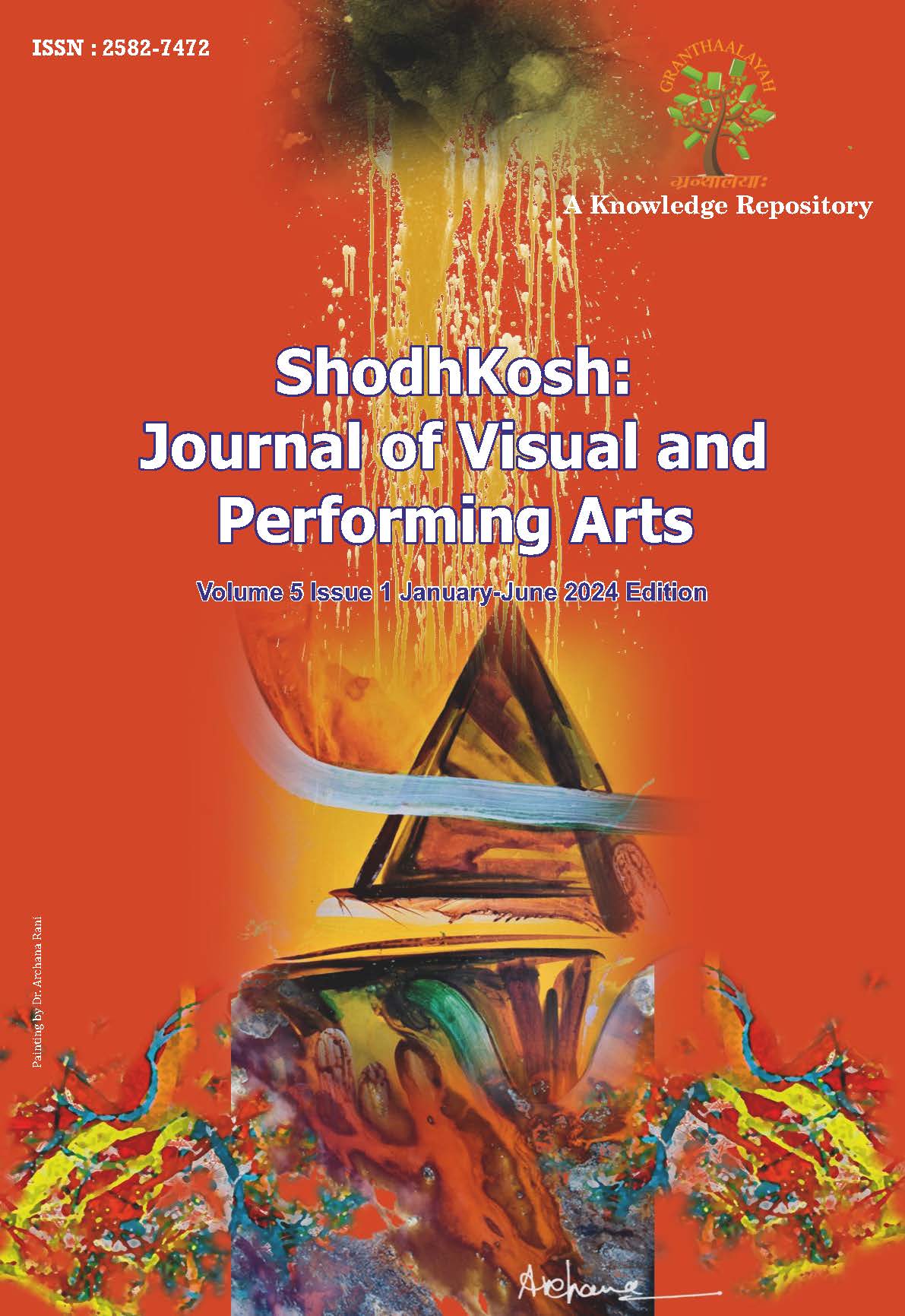SIGNIFICANCE OF TRADITIONAL COSTUME, CLOTHING, AND ITS MOTIF IN THE RABHA SOCIETY
DOI:
https://doi.org/10.29121/shodhkosh.v5.i1.2024.1574Keywords:
Tradition textile, Motif, Culture, Design Significance, Social DesignAbstract [English]
Clothes are our second skin. We wear them from the time we are born until we die. Clothes play a very important part in our lives and our existence. It gives us our identity and adds to our personality. Traditional clothing and design hold significant importance in all the various cultures around the world. They are not just garments to wear; they carry history, identity, cultural heritage, and artistic expression. Traditional clothing represents a cultural identity and heritage that distinguishes one community or group from another. It helps them connect to their roots, ancestors, and shared history. There is not much literature found about traditional clothing, its design, motifs, its meaning, and its significance in society. In this paper, we will study the Rabha tribe, a prominent tribe from Northeast India, Assam, In the socio-cultural construct they live in, visual characteristics like color, motif, and design of traditional clothing plays a very important role. This paper aims to study Rabha’s traditional clothing, its design, and its significance in Rabha society.
For the study, primary and secondary research methods were used. For secondary research, research papers and books on the Rabha tribe are refereed. For primary research field trips were made to places like Goalpara where the Rabha population inhabitant. Eminent personalities like nation awardee Weaver, Rabha museum curator, etc. were interviewed. Different museums, and libraries. Conventions, exhibitions, etc. were also attended to collect relevant data.
Traditional designs often carry symbolic meanings that convey important messages within cultures. Colors, patterns, and motifs can represent elements like status, marital status, social roles, spiritual beliefs, good luck, protection, religious beliefs, and more. These symbols create a shared language among members of the Rabha community and are often passed down through generations. Rabha clothes, design, motifs, and their meaning and significance are presented in detail in the paper.
References
Anon., 2022. des.assam.gov.in/information-service. [Online]
Available at: n 2020. Custom law and penal code of the Rabha society. Dudhnoi.: RHAC.
B.N. Bordoloi, G. T., n.d. Tribes of Assam, Part-I. s.l.:s.n.
Baglary, M., 2022. MARRIAGE SYSEM AMONG THE TOTOLA RABHAS: A BRIEF STUDY.
International Journal of Creative Research Thoughts.
Barbhuiya, M. K., 2021. Material Culture Of Assam: An Analytical Study. Ilkogretim Online - Elementary Education Online.
Barmahalia, D. F., 2018. Folklore and Ethnicity: A Study among the Rabhas of Assam. International Journal of Creative Research Thoughts.
Baruah, B. D., Jan 2013. In: Utar Purbanchalor Jonogusthio Hajpar aru AA=Alankar. Guwahati: M.R. Publication,Pan Bazar, Guwahati.
Basumatārī, P. C., an 2010. The Rabha Tribe of North-East India, Bengal and Bangladesh. In: s.l.:Mittal Publications.
Basumatary, S., 2016. Weaving: A Traditional Domestic Expertise of the Rabhas of Assam. Social Research Foundation, VOL. -V, ISSUE-II.
Bora, D. B., 2020. Development Model in Rural Assam: An Analysis of the Rabha Community in Baksa District, Assam. INTERNATIONAL JOURNAL FOR INNOVATIVE RESEARCH IN MULTIDISCIPLINARY FIELD.
G.C.Kakoti, n.d.
Goutom Sharma, J. B., n.d. Textile traditional of assam-collection of purbajyoti sangrahalaya. Kolkata: Indian Museum.
Khabir Ahmed, a. D. S. R. M., 2021. An Ethno-Socio-Cultural Study Of Rabha In The North Bengal Of West Bengal. Ilkogretim Online - Elementary Education Online.
Krishna Sarma, ,. s. D., 2019. Assam-A journey through its textiles. New dDlhi: Speaking tiger publication.. mazumdar, L., Nov 2013. Textile tradition of assam-an empirical study. s.l.:Bhabani books & Fabric plus.. Nath, C. R., 2020. Folk Culture of Rabha Tribe: Changes and its Preservation. JETIR.
Rabha, D., n.d. Rabha Jonojatir Chomu Itihakh. s.l.:s.n.
Rabha, H., 2021. Hannaghora Dance Prevelant Amoing Rava community Of Assam-An Overview.
PalArch's Journal Of Archaeology of Egypt / Egyptology.
Raha, M. K., 1989. Matriliny to Patriliny: A Study of the Rabha Society:. Cooch Behār (India): Gian Publishing House,.
Rajkhowa, E. b. A., Jan 2013. Uttar Pubancholor Jonogusthio Hajpaar aru aa-alankar. Guwahati: Banphool Prakashan.
Sarkar, H., n.d. Rabha Homaj Aru Sanskritir Abhakh. s.l.:s.n.
Sarma, D. H., 2022. Multiculturalism and Changing Contours of the Rabhas in Assam: A Philosophical Perspective. International Research Journal (Double-blind peer-reviewed).
Sarma, D. J. D., July 2022. Traditional textiles of Assam. Guwahati: HD Internonal Educational Publisher. Sarma, D. J. D., June 2019. Bastra katha. s.l.:.pragjyotishpur sahitya sabha.
Sarma, H., 2008. The Spring Time Festival ‘Baikho’ in Rabha Culture:Continuity and Change. Journal of Advances and Scholarly Researches in Allied Education.
Sarma, L., July 2021. A discourse on the significance of Bogejari Songs and Maare songs in the folk life of the Pati Rabhas of Assam. Pratidhwani the Echo.
Sen, A., 2016. SOME BASIC OBSERVATION ON THE RABHA SOCIETY AND CULTURE. Indian
Streams Research Journal.
Thakuria, D., 2023. Socio- Cultural Aspects of the Rabha Community: A Study in Western Assam. IOSR Journal Of Humanities And Social Science.Thakuria, D., 2023. Socio- Cultural Aspects of the Rabha Community: A Study in Western Assam. IOSR Journal Of Humanities And Social Science.
Published
How to Cite
Issue
Section
License
Copyright (c) 2024 Amardeep Rabha

This work is licensed under a Creative Commons Attribution 4.0 International License.
With the licence CC-BY, authors retain the copyright, allowing anyone to download, reuse, re-print, modify, distribute, and/or copy their contribution. The work must be properly attributed to its author.
It is not necessary to ask for further permission from the author or journal board.
This journal provides immediate open access to its content on the principle that making research freely available to the public supports a greater global exchange of knowledge.































